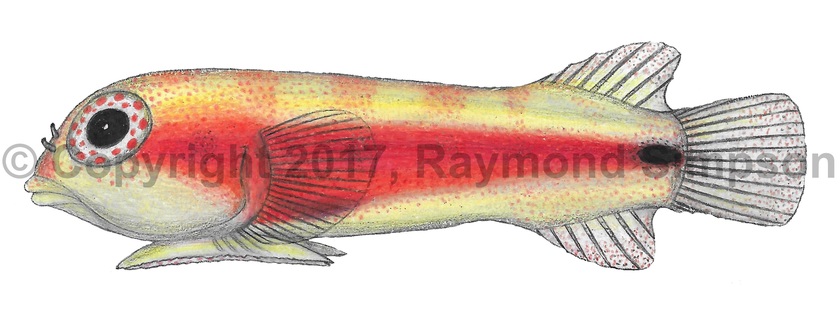
Common Name
Tailspot Clingfish
Year Described
Sparks & Gruber 2012
Identification
Dorsal Fin: 8
Anal Fin: 7
Pectoral Fin: 23-24
Caudal Fin: 7+6
Vertebrae: 25
Body stout but relatively elongated (maximum depth 4 times in SL). Eye relatively large (diameter a little larger than interorbital width). Forehead profile steep. Teeth trifid anteriorly. Mouth very small. Nostrils tubular and close together. Gill membranes attached to isthmus. Subopercle without a spine. Three of four gill arches with filaments. Fin rays are all unbranched. Pelvic disk well developed and covered in patches of papillae. Center of anterior disk region C with two separate clusters of 8-9 close-set papillae (with a single papilla in front of each cluster) and posteriorly a crescent of five papillae with a single papillae preceding it. Rear edge of sucker strongly convex. Fleshy pad on lower pectoral base poorly developed. Median fins placed far back on body. Tail truncate.
Color
Body translucent with a bright red-orange stripe from the cheek to the base of the tail. Cheek rosy red. Fine red speckles on head and anterior body. An oblong black to dark red spot on the caudal peduncle There are several faint orange bands across the back. Eyes yellow with numerous red spots. Median fins clear with rosy tips and red speckles on finrays. Pelvic disk yellowish. Pectoral fins clear.
Size
A tiny species: to 15mm SL.
Habitat
Lives on deep coral reefs among live corals and gorgonians. Depth range is 30-132m.
Range
Known from the Bahamas, the Cayman Is. and St. Eustatius.
References
Sparks, J.S. & D.F. Gruber. 2012. A new mesophotic clingfish (Teleostei: Gobiesocidae) from the Bahamas. Copeia, 2012(2), 251-256.